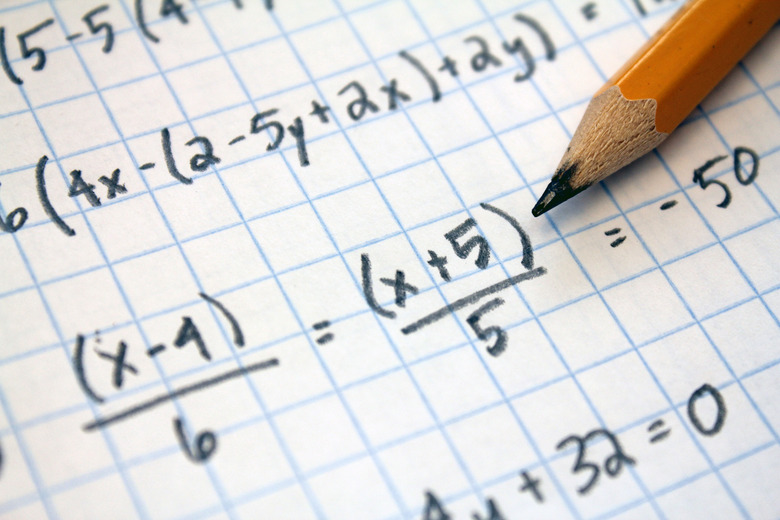Tips For Solving Algebraic Equations
Algebra marks the first true conceptual leap students must make in the world of mathematics, learning to manipulate variables and work with equations. As you begin working with equations, you'll encounter some common challenges including exponents, fractions and multiple variables. All of these can be mastered with the help of a few basic strategies.
The Basic Strategy for Algebraic Equations
The Basic Strategy for Algebraic Equations
The basic strategy for solving any algebraic equation is to first isolate the variable term on one side of the equation, and then apply inverse operations as necessary to strip away any coefficients or exponents. An inverse operation "undoes" another operation; for example, division "undoes" the multiplication of a coefficient, and square roots "undo" the squaring operation of a second-power exponent.
Note that if you apply an operation to one side of an equation, you must apply the same operation on the other side of the equation. By maintaining this rule, you can change the way the terms of an equation are written without changing their relation to each other.
Solving Equations With Exponents
Solving Equations With Exponents
The types of equations with exponents you'll encounter during your algebra journey could easily fill an entire book. For now, focus on mastering the most basic of exponent equations, where you have a single variable term with an exponent. For example:
\(y^2 + 3 = 19\)
1. Isolate the Variable
Subtract 3 from both sides of the equation, leaving the variable term isolated on one side:
\(y^2 = 16\)
2. Apply a Radical
Strip the exponent away from the variable by applying a radical of the same index. Remember, you must do this to both sides of the equation. In this case, that means taking the square root of both sides:
\(\sqrt{y^2} = \sqrt{16}\)
Which simplifies to:
\(y = 4\)
Solving Equations With Fractions
Solving Equations With Fractions
What if your equation involves a fraction? Consider the example of
\(\frac{3}{4}(x + 7) = 6\)
If you distribute the fraction 3/4 across (x + 7), things can get messy fast. Here's a much simpler strategy.
1. Multiply by the Denominator
Multiply both sides of the equation by the fraction's denominator. In this case, that means multiplying both sides of the fraction by 4:
\(\frac{3}{4}(x + 7) × 4 = 6 × 4\)
2. Simplify Both Sides
Simplify both sides of the equation. This works out to:
\(3(x + 7) = 24\)
You can simplify again, resulting in:
\(3x + 21 = 24\)
3. Isolate the Variable
Subtract 21 from both sides, isolating the variable term on one side of the equation:
\(3x = 3\)
4. Solve for x
Finally, divide both sides of the equation by 3 to finish solving for x:
\(x = 1\)
Solving One Equation With Two Variables
Solving One Equation With Two Variables
If you have one equation with two variables, you'll probably be asked to solve for just one of those variables. In that case you follow much the same procedure as you'd use for any algebraic equation with one variable. Consider the example
\(5x + 4 = 2y\)
if you're asked to solve for x.
1. Isolate the Variable Term
Subtract 3 from each side of the equation, leaving the x term by itself on one side of the equal sign:
\(5x = 2y – 4\)
2. Strip Away Any Coefficients
Divide both sides of the equation by 5 to remove the coefficient from the x term:
\(x = \frac{2y – 4}{5}\)
If you're given no other information, this is as far as you can take the calculations.
Solving Two Equations With Two Variables
Solving Two Equations With Two Variables
If you're given a system (or group) of two equations that have the same two variables in them, this usually means the equations are related – and you can use a technique called substitution to find values for both variables. Consider the equation from the last example, plus a second, related equation that uses the same variables:
\(5x + 4 = 2y \
x + 3y = 23\)
1. Solve for One Variable
Choose one equation, and solve that equation for one of the variables. In this case, use what you already know about the first equation from the previous example, which you already solved for x:
\(x = \frac{2y – 4}{5}\)
2. Substitute the Result Into the Other Equation
Substitute the result from Step 1 into the other equation. In other words, substitute the value (2y – 4)/5 for any instances of x in the other equation. This gives you an equation with just one variable:
\(\frac{2y – 4}{5} + 3y = 23\)
3. Solve for the Variable
Simplify the equation from Step 2 and solve for the remaining variable, which in this case is y.
Start by multiplying both sides by 5:
\(5 × \bigg( \frac{2y – 4}{5} + 3y\bigg) = 5 × 23\)
This simplifies to:
\(2y – 4 + 15y = 115\)
After combining like terms, this further simplifies to:
\(17y = 119\)
And finally, after dividing both sides by 17, you have:
\(y = 7\)
4. Substitute This Value In
Substitute the value from Step 3 into the equation from Step 1. This gives you:
\(x = \frac{(2 × 7) – 4}{5}\)
Which simplifies to reveal the value of x:
\(x = 2\)
So the solution for this system of equations is x = 2 and y = 7.
Cite This Article
MLA
Maloney, Lisa. "Tips For Solving Algebraic Equations" sciencing.com, https://www.sciencing.com/tips-for-solving-algebraic-equations-13712207/. 4 December 2020.
APA
Maloney, Lisa. (2020, December 4). Tips For Solving Algebraic Equations. sciencing.com. Retrieved from https://www.sciencing.com/tips-for-solving-algebraic-equations-13712207/
Chicago
Maloney, Lisa. Tips For Solving Algebraic Equations last modified August 30, 2022. https://www.sciencing.com/tips-for-solving-algebraic-equations-13712207/
